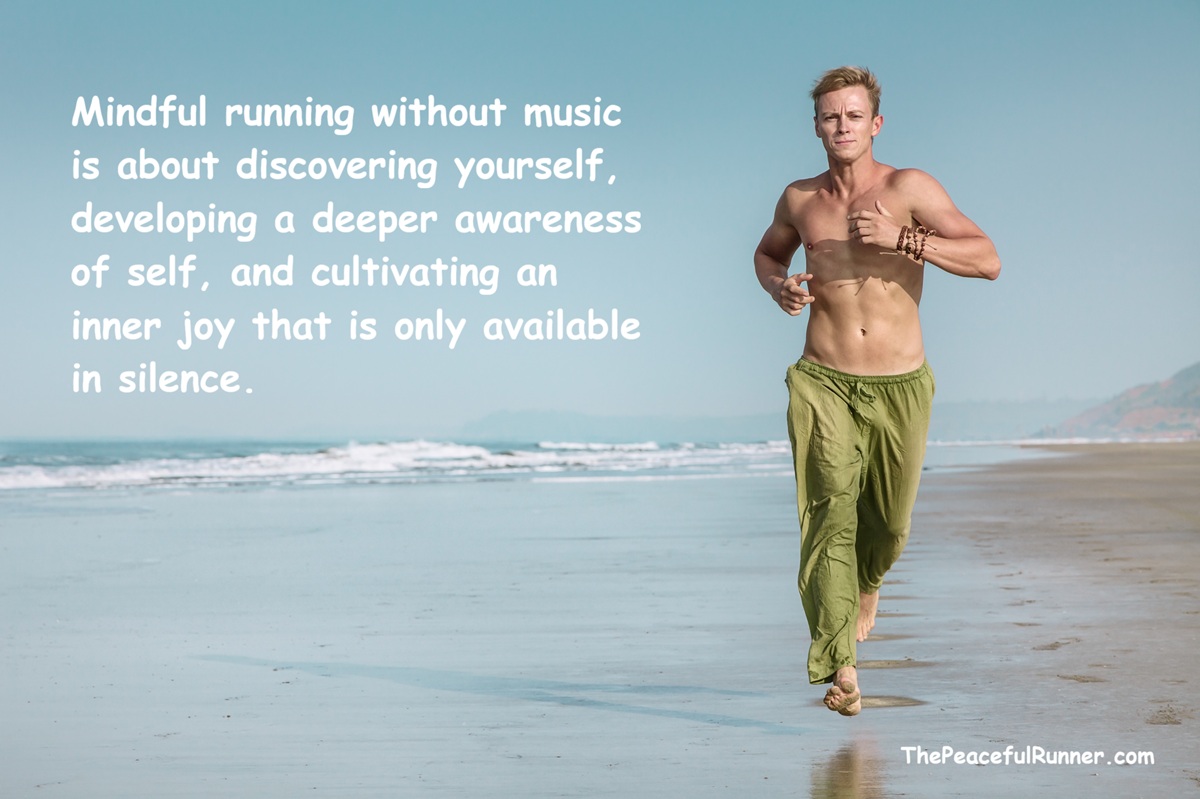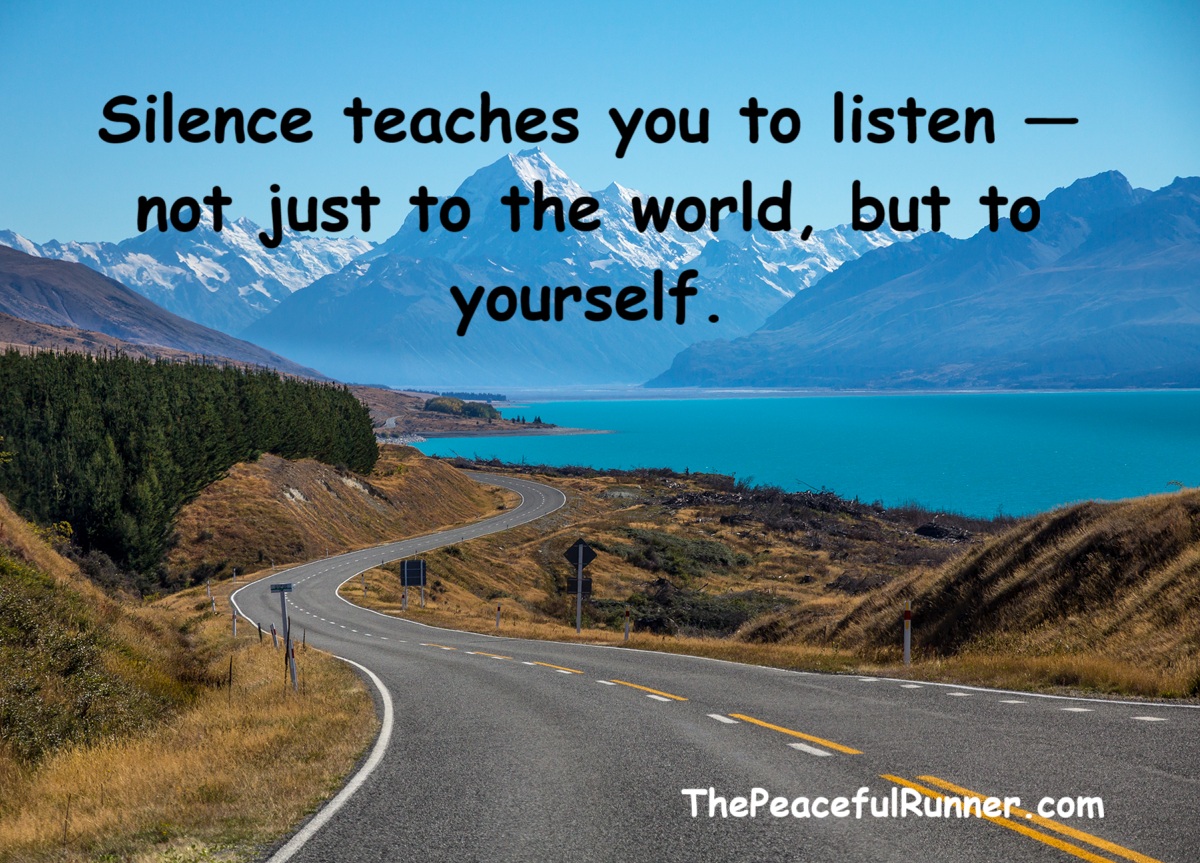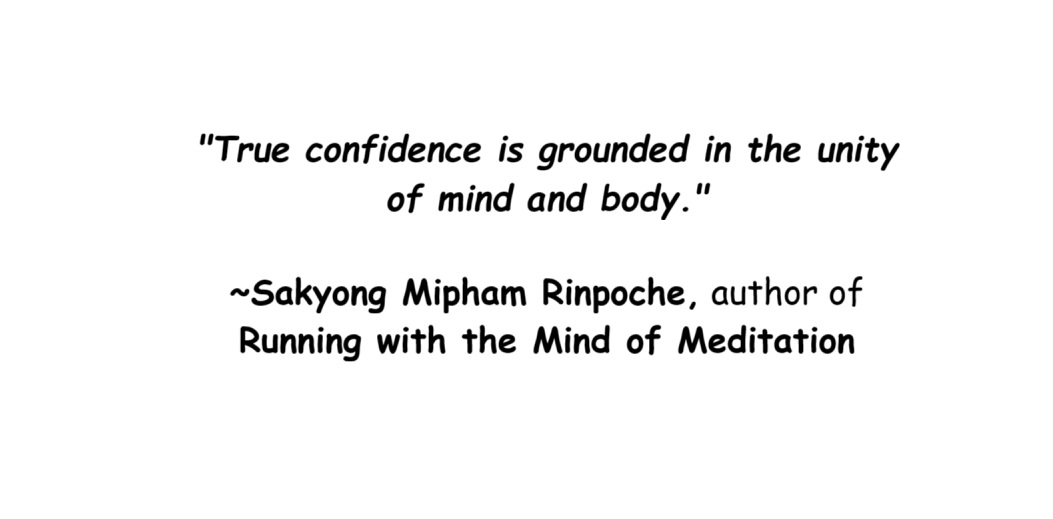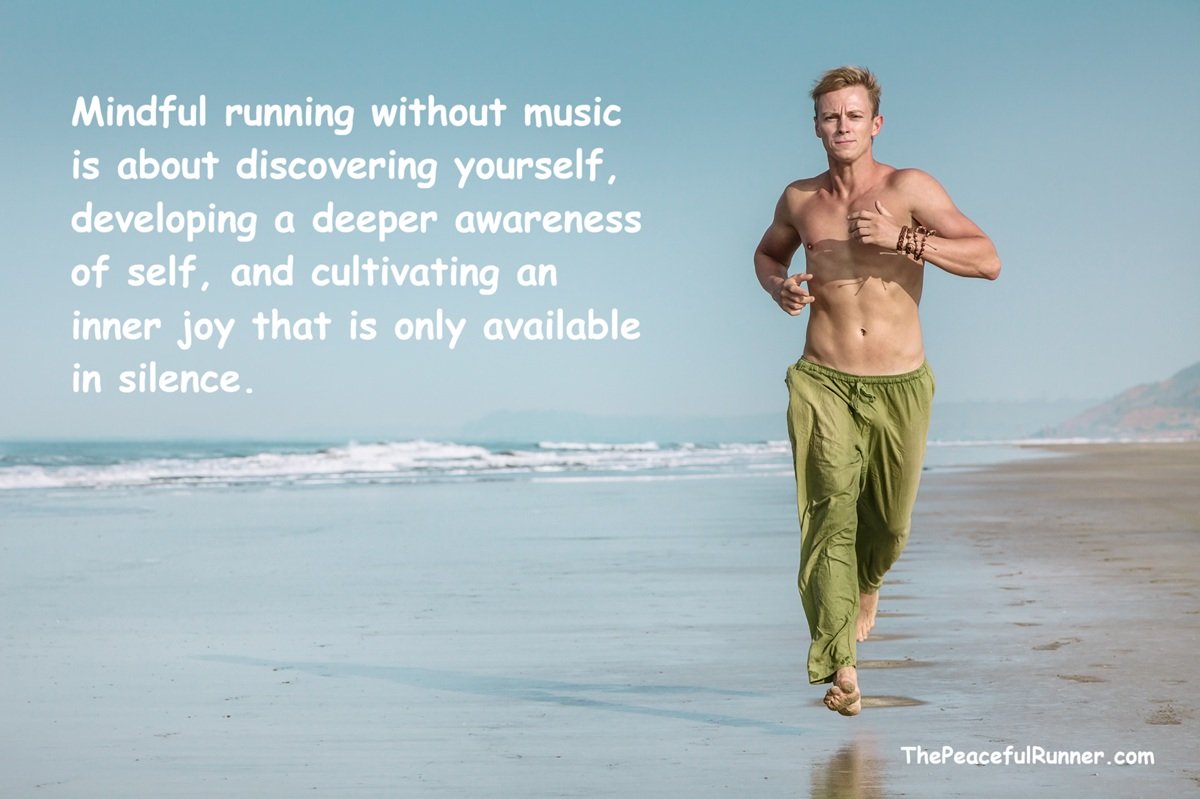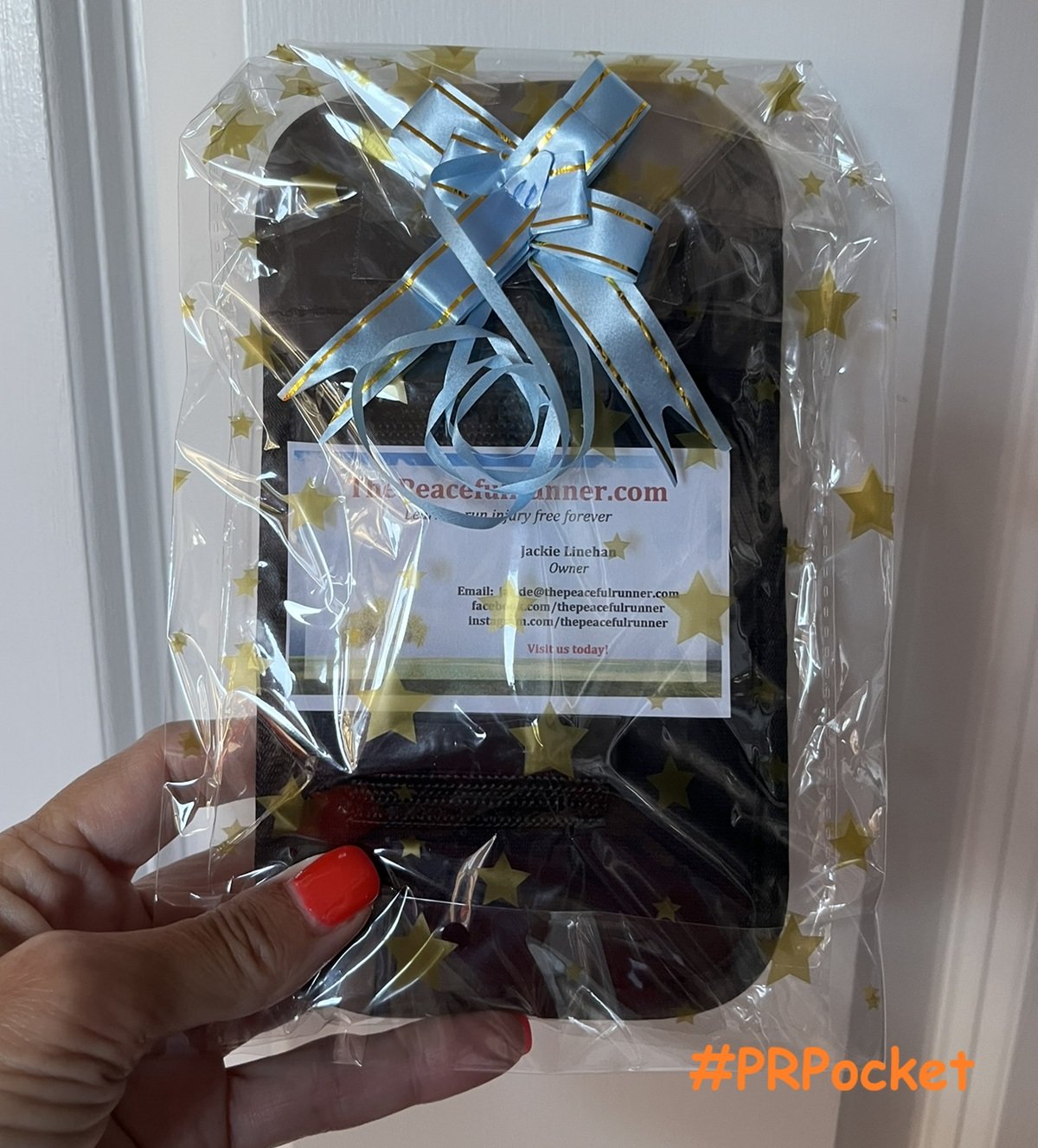- Home
- Running & Meditation
- Mindful Running Without Music
Mindful Running Without Music
FTC Disclosure: As an Amazon Associate, I earn from qualifying purchases. Learn more
Most runners instinctively reach for their earbuds before lacing up their shoes. The beat sets the pace, the playlist powers the miles — but what if silence could do even more? Mindful running without music invites you to experience running as a form of moving meditation. Without the distraction of songs or podcasts, every breath, step, and heartbeat becomes a rhythm of awareness. You start to notice the sound of your feet on the ground, subtle sensations in your body, a deeper awareness of self — and with it, an inner joy, and new ideas that seem to appear from nowhere.
This isn’t about giving something up; it’s about discovering yourself. By running in silence, you reconnect with your mind and body, finding calm, focus, and clarity that no playlist can provide. In this article, we’ll explore why running without music enhances mindfulness — and how you can begin to enjoy and experience mindful, music-free movement.
Why Do So Many Runners Listen to Music?
For many runners, music is as essential as their shoes. It can be a powerful motivator, helping beginners stay consistent and giving experienced runners a performance boost when energy dips. Scientific studies even show that listening to upbeat music can reduce perceived effort, elevate mood, and improve endurance.
There’s no denying that music can make running more enjoyable, but it also drowns out something far more meaningful: the quiet conversation between your mind and body. When we depend on constant sound, we lose touch with the subtle internal cues that anchor us in the present moment and deepen inner body awareness. Mindful running offers a different, more grounded experience — one that begins the instant you leave your headphones behind.
I understand that beginner runners often feel they need music to stay motivated until their muscles, joints, and endurance adapt to running. But relying too heavily on it can hold them back from developing their own inner drive, focus, and body awareness. Over time, this dependence on external stimulation can prevent them from discovering just how great it feels to run freely under your own power.
Many runners use music as a distraction from the pain and discomfort that often arise during a run. But running carries both pain and pleasure — and learning to face both is part of the practice. When we allow ourselves to fully notice and explore the sensations of running pain and discomfort, we develop a deeper understanding of our bodies. This awareness teaches us how to respond to pain intelligently, helping to prevent injuries rather than ignore them. As we stay present with these sensations, we build confidence in our mind and body’s ability to manage discomfort — transforming what once felt like struggle into mindful strength.
What Happens When You Run Without Music
Many runners turn to music to drown out the stream of thoughts that surface while running. Yet those thoughts don’t disappear; they simply wait beneath the noise. True release comes only when we allow them to rise, acknowledge them, and let them go. During a mindful run, silence becomes a mirror — a space where clarity, insight, and creativity often emerge. Without music, runners frequently discover new ideas, fresh perspectives, and even solutions to problems that stay hidden when the mind is filled with sound.
Running can be a meditative experience when there are no external distractions. There is a natural harmony and balance that exists when we run with mind and body fully connected as one. We empower both mind and body when we give them our full attention, which allows us to fully engage with the whole running experience and to develop our inner strength.
The first few runs without music often feel strange — even uncomfortable. Without the steady beat or familiar playlist, you suddenly notice every sound and every sensation. But that initial silence is exactly where mindful running without music begins. Silence has a settling effect on the nervous system. Instead of overstimulation, you experience calm and clarity — much like the mental reset meditation provides. As you settle into your own natural rhythm, calm awareness replaces distraction. You start to tune in — not out.
Running without music invites you to listen inward. You feel how your feet meet the ground, how your hips move, how your lungs expand, how your posture shifts with each stride. The mind becomes quieter, the senses sharper. What once felt like effort begins to flow, as if your body and breath are moving together in meditation.
In short, mindful running without music brings you back to yourself. It turns each run into a space for reflection, clarity, and inner balance — qualities that no playlist can provide.
This is the heart of mindful running: learning to be fully present in motion. In the absence of sound, you discover a deeper kind of rhythm — one that’s not powered by beats per minute, but by pure and blissful awareness.
How to Start Mindful Running Without Music
If you’ve always run with music, silence can feel awkward at first. The mind searches for noise, rhythm, or distraction — but this is where mindfulness begins. The goal isn’t to fight the silence; it’s to listen to it.
To develop a strong unity of mind and body, we must be mentally present while running. Follow your breath and focus on where you feel it in your body. Our breath can connect us with our life energy force (prana) which has the ability to provide us with energy, keep us present and increase body awareness, which helps prevent injuries and improve running form.
Here’s how to start your journey into mindful running without music one step at a time:
1. Begin with a Short, Silent Run
Start small. Choose one easy run each week to leave the headphones behind. Notice the sounds around you — your breath, your feet, the wind. Treat it as an experiment, not a test.
2. Focus on Your Breath and Cadence
Let your breath become your natural metronome. Feel how your inhale and exhale match your stride. Breathing awareness keeps you grounded in the present and helps maintain rhythm without external beats.
3. Tune Into Your Senses
Pay attention to everything you usually tune out — the temperature of the air, the texture of the ground, how your arms swing. This sensory awareness transforms running into a moving meditation.
4. Run a Familiar Route
Choose a path you know well. Without needing to think about direction or terrain, your attention can rest fully on mindfulness and body awareness.
5. End with Reflection
After your run, take a minute to notice how you feel. Was your mind calmer? Did you breathe more naturally? Reflection reinforces mindfulness and makes silence feel rewarding rather than empty. Remember to praise yourself for this run — powered only by your own internal rhythm and you've practiced self-discipline, mindfulness, and awareness all at once!
Transitioning to silence isn’t about giving something up — it’s about discovering yourself, developing a deeper awareness of self, and cultivating an inner joy that is only available in silence. With each music-free run, you’ll find more focus, calm, and connection — both on the road and within yourself.
More on How to Run Mindfully
When Music Still Has a Place in Running
Even if you embrace mindful running without music, it doesn’t mean music has no place in your training. Like mindfulness itself, balance matters. The goal isn’t to eliminate music completely — it’s to use it consciously rather than automatically.
There are moments when music can uplift, motivate, or help you push through physical challenges. On high-intensity or treadmill runs, a strong beat can fuel endurance and focus. During long solo miles, a favorite song can lift your spirits when energy dips. The key is intentional use — choosing when music enhances your experience and when silence deepens it.
Mindfulness isn’t about rules; it’s about awareness. By recognizing how different sounds affect your focus, breathing, and mood, you gain the power to decide. Some days, silence will serve you best. Other days, the rhythm of your playlist might be exactly what moves you forward.
The difference is that now, you’re not running from silence — you’re running with awareness of when sound supports you and when it steals your attention.
Running in Silence and Mental Health
Silence doesn’t just sharpen focus — it heals. Running without music creates the space for your thoughts to breathe, your emotions to settle, and your nervous system to reset. It’s a form of meditation in motion, where each step becomes both grounding and releasing.
When you remove external noise, your mind begins to process internal noise — the stream of thoughts, worries, or emotions you’ve been carrying. Instead of escaping them with a playlist, you move through them with presence. Over time, mindful running without music helps reduce stress, ease anxiety, and improve emotional regulation — effects similar to those found in traditional mindfulness or meditation practice.
Science supports what many mindful runners already feel: slow, steady, attentive running lowers cortisol, boosts mood-regulating endorphins, and increases clarity. You’re not just improving fitness; you’re training emotional balance.
In silence, running becomes more than exercise — it becomes therapy. A way to listen, to release, and to return home to yourself.
Why I Choose Not to Listen to Music While Running
I’ve never listened to music while running — and I’m pretty sure I never will. When I first started running, my choice was mostly practical. I wanted to keep things simple. The idea of strapping on a device and running with wires bouncing around (this was long before wireless earbuds!) just didn’t appeal to me. I preferred to travel light — to run free, unencumbered, and without noise.
Now, after many years of running in silence, I know I’ll never want to listen to music while I run — but for reasons far deeper than practicality. For me, running is about cultivating both mental and physical strength, and the quiet confidence that comes from trusting my body. It’s about being fully present with the sensation of running and movement and discovering what feels natural and effortless. It is an opportunity to experience genuine peace, clarity, and connection — an opportunity to enjoy and focus on the world around me and how my body feels when in motion.
However, I do make one exception. That is when I listen to a Guided Running Meditation, which achieves the same results as mindful running — in my humble opinion!
FAQ: Mindful Running Without Music
Q1: Is it better to run with or without music?
Q1: Is it better to run with or without music?
It depends on your goal. Music can motivate and energize, but running without it enhances mindfulness and focus. Silent runs help you tune into your breath, posture, and rhythm — creating a deeper connection with your body and the present moment.
Q2: How does silence improve mindfulness while running?
Q2: How does silence improve mindfulness while running?
Silence removes distractions. Without music, your awareness expands — you notice each step, sound, and sensation. This natural attention shift strengthens mindfulness, reduces mental noise, and creates a meditative rhythm through movement.
Q3: Can I still be mindful when listening to music?
Q3: Can I still be mindful when listening to music?
Yes, but it’s harder. You can practice mindfulness by noticing the effects of music — how it changes your mood, pace, or focus. The key is awareness. When you consciously choose to run with or without music, you’re already practicing mindfulness.
Q4: What are the benefits of running in silence?
Q4: What are the benefits of running in silence?
Running in silence can improve focus, body awareness, and emotional balance. It lowers stress, enhances breathing rhythm, and deepens your connection to nature and self — turning each run into meditation in motion.
Q5: How can I start running without music?
Q5: How can I start running without music?
Begin with one silent run each week. Focus on your breath and senses, notice your surroundings, and reflect afterward. Gradually, silence will start to feel natural — even liberating.
Final Reflection: Reclaiming Your Runs Through Mindfulness
Listening to your favorite playlist while running can be an enjoyable way to unwind, but it may also drown out important messages from your body. When the music takes over, it becomes harder to tune into your natural pace, improve your cadence, and monitor your breathing — or to notice how your legs feel and how your feet are landing. You may also miss subtle signs of tension or fatigue, the kind of feedback that helps you adjust before small issues turn into injuries. Running without music gives you the chance to listen inward — to connect, correct, and grow stronger with every step.
Silence can feel unfamiliar at first, but it quickly becomes something deeper — a kind of freedom. When you set aside the playlist and step into stillness, you rediscover what running truly is: movement, breath, and presence working together. Mindful running without music isn’t about restriction; it’s about reconnection.
In that quiet space, the world opens up. You hear your breath syncing with your stride, the rhythm of your feet against the earth, the subtle sounds of life around you. Every run becomes a meditation in motion — a return to yourself, step by step.
So next time you lace up, consider leaving the headphones behind. Let silence guide your pace, and awareness carry you forward. You may find that what you were chasing in music was always there — waiting in the rhythm of your own breath.
Running can be an amazing journey of discovery and growth. Be present and enjoy it fully!
Do you usually listen to music when you run? If so, here’s a simple challenge: try leaving your headphones behind on your next run. You might be surprised by how natural — and even refreshing — the silence feels. Afterwards, share your experience or thoughts in the comments below. We’d love to hear what makes running meaningful and enjoyable for you!
Want to learn more about how meditation and running work together? Visit our guide on Running and Meditation
Back to top of Mindful Running Without Music
- Home
- Running & Meditation
- Mindful Running Without Music
FTC Disclosure: As an Amazon Associate, I earn from qualifying purchases. Learn more
NEW FEATURE - DISQUS COMMENTS!
Login using Facebook, Twitter, Google or Disqus.
Recent Articles
-
How to Choose the Best Treadmill for Your Home
Dec 10, 25 07:13 AM
-
Winter Running Tips and the Best Waterproof Running Shoes
Nov 15, 25 01:55 PM
-
When the Music Stops, Awareness Begins
Nov 05, 25 10:54 AM
-
Get yours in time for gift giving!
Oct 24, 25 12:32 PM
-
Change How You Deal with Running Pain
Oct 10, 25 08:53 AM
-
Surprising Benefits of Backwards Running
Sep 15, 25 12:40 PM
-
It's an Awesome Product!
Aug 28, 25 09:25 AM
I went out for a walk this morning and I used the #PRPocket for the first time. I had to check at least 3 times because I thought I lost my phone (iPhone -
Running in Hot Weather: What Every Runner Needs to Know!
Aug 14, 25 01:00 PM
-
Sick of Dieting? You’re Not Alone — And There Is a Better Way.
Jul 30, 25 12:18 PM
-
Tips and Drills to Improve Your Running Cadence
Jul 25, 25 12:52 PM

